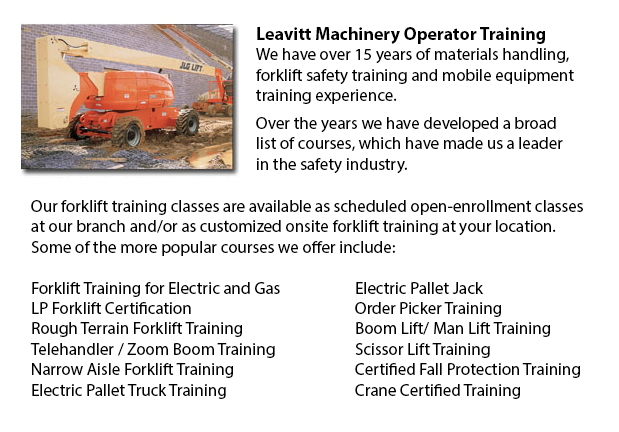
St Catharines Manlift Training - There are a lot of manlift training programs which provide a review of the manlift machine. The practicum part of the training is one more important portion of the course. In this part the trainee has chance to show their practical abilities, their ability to safely operate a manlift. A prerequisite to Manlift training is the fall protection training, which can be incorporated in the training based on the specific requirements of the client.
Course Content
The program comprises the following areas of instruction: pre-shift equipment inspection and work area survey requirements; the effect of doing unsafe acts or operating unsafe equipment, Lifting device machine definitions, Review of load capabilities, the particular machine requirements and safety decals, Review of related sections of the OSHA Standards and the CSA Standards and Review site particular Hazards, together with controls for safe use of a lifting device.
Demonstration and Evaluation Content
Demonstration and evaluation content comprises: Using a signaler or a spotter when needed; Proper personal protective equipment or also referred to as P.P.E. as needed; Using the proper fitting harness or fall arrest devise; Using a lift just on solid and level ground; Aware of load limits etc. and other specs set out by the manufacturer; Operating the lift with all other employees clear of the job place; Pre-shift work area survey and equipment check; Having all associated machinery stored safely on the lift platform; Ensuring a safe and smooth operating speed for various plant conditions and isolating off the work area when major work projects are to be done.
Each individual would be tested to make sure they could safely and efficiently utilize your site-specific equipment.
Manlift Safety
Because the manlift is capable of lifting personnel and materials over 20 feet in the air, these machines pose a particular amount of risk and can be dangerous machinery if not utilized correctly. Since the danger is so apparent, lift owners and operators are careful to correctly maintain their equipment and follow correct safety precautions and operating procedures. The ratio of accidents involving this specific machinery is rather low.
The safety specifications for boom lifts and scissor lifts puts the burden for safe manlift operation on the user. You are responsible for knowing how to safely operate the lift even if you just rent the machine for a day. The most basic safety features on the equipment are safety decals and the operating guidebook. These show important information about the operating procedures, safety machines and maintenance.
Newer lift models will come along with guidebooks and decals in place. Technically, the operating handbook should be kept on the lift itself. If you are buying a used lift, it is important to ensure that the instruction booklet is included and that vital decals haven't been painted over. The restraints that prevent operators from falling and the guardrails are other vital safety features. These are standard and mandatory on all types of lifts.
-
St Catharines Heavy Equipment Training Schools
St Catharines Heavy Equipment Training Schools - When selecting an operator training course, there are a lot of heavy equipment training schools to choose from. To be able to ascertain the qualifications you will attain, it is very important to explo... More -
St Catharines Heavy Equipment Operator Training
St Catharines Heavy Equipment Operator Training - Heavy equipment operator training facilities that offer quality standards within the business, offering field performance work and additional machine training are really sought after training features... More -
St Catharines Forklift Training Programs
St Catharines Forklift Training Programs - Are you looking for work as a driver of a forklift? Our regulatory-compliant mobile equipment operator training offers instruction in kinds of forklifts, pre-shift check, fuel kinds and handling of fuels, an... More -
St Catharines Heavy Equipment License
St Catharines Heavy Equipment License - A heavy equipment license can be obtained by taking a certification and preparation course at a private training school or a vocational school. This license would qualify you to operate various types of heavy e... More -
St Catharines Overhead Crane Safety Training
St Catharines Overhead Crane Safety Training - Overhead crane safety training equips operators with skills and knowledge regarding crane safety precautions, accident avoidance, materials handling, and equipment and stock protection. Trainees will lea... More -
St Catharines Scissor Lift Training
St Catharines Scissor Lift Training - Scissor lifts should be operated proficiently to be able to protect the safety of the equipment and the wellbeing of others within the workplace. Operators who are skilled are trained to drive the specific type o... More -
St Catharines Telescopic Training
St Catharines Telescopic Training - Telescopic Handlers are a kind of forklift, normally known as telehandlers. This machine has been increasing in popularity due to its greater lift heights and its versatility. It is often preferred over the convent... More -
St Catharines Boom Lift Certification
St Catharines Boom Lift Certification - Utilizing elevated work platforms allow for maintenance operations and work to be carried out at elevated work heights which were otherwise unreachable. Boom Lift Certification Training educates workers about t... More

Forklift Certification St Catharines
TOLL FREE: 1-888-254-6157
St Catharines, Ontario
forkliftcertificationstcatharines.com/
Email Us
About Us


